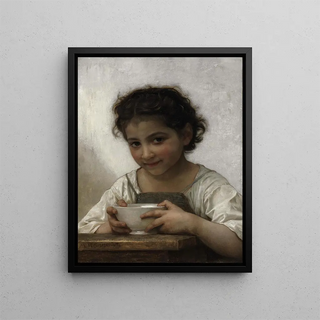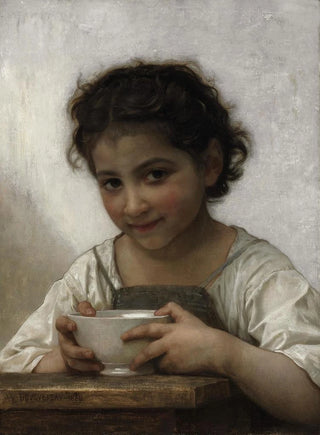Art print | La soupe au lait - William Bouguereau


View from behind

Frame (optional)
Art print La soupe au lait - William Bouguereau – Captivating Introduction
In the rich and complex universe of 19th-century academic painting, "La soupe au lait" by William Bouguereau stands out as an iconic work that transcends time. This canvas, of rare emotional depth, invites the viewer to immerse themselves in a moment of everyday life, where the simplicity of gestures blends with dramatic intensity. Bouguereau, an undisputed master of figurative art, succeeds in capturing childhood innocence while celebrating the beauty of domestic scenes. The scene depicts a young girl, absorbed in preparing a modest meal, yet filled with tenderness. This work, both touching and realistic, evokes childhood memories and family values, offering a reflection on simple yet precious life.
Style and uniqueness of the work
Bouguereau's style is characterized by striking realism and meticulous attention to detail. "La soupe au lait" is no exception. The textures of the clothing, the brightness of the colors, and the delicate expression on the girl's face all demonstrate exceptional craftsmanship. The artist uses light masterfully, creating plays of shadow and illumination that give the scene a warm and intimate atmosphere. The composition is also thoughtfully arranged, with each element positioned to guide the viewer's gaze toward the main subject. Bouguereau thus manages to establish a dialogue between the subject and the observer, making the visual experience deeply immersive. This ability to transform ordinary moments into poignant moments of beauty is what makes the work unique.
The artist and his influence
William Bouguereau, born in 1825, is one of the most emblematic representatives of the French academic movement. His career, marked by numerous successes, reflects an era when art was considered a means to glorify beauty and truth. Bouguereau managed to establish himself in a rapidly changing artistic world, where Impressionist currents were beginning to emerge. Although he was often criticized for his attachment to academic conventions, his influence on his contemporaries

Matte finish

View from behind

Frame (optional)
Art print La soupe au lait - William Bouguereau – Captivating Introduction
In the rich and complex universe of 19th-century academic painting, "La soupe au lait" by William Bouguereau stands out as an iconic work that transcends time. This canvas, of rare emotional depth, invites the viewer to immerse themselves in a moment of everyday life, where the simplicity of gestures blends with dramatic intensity. Bouguereau, an undisputed master of figurative art, succeeds in capturing childhood innocence while celebrating the beauty of domestic scenes. The scene depicts a young girl, absorbed in preparing a modest meal, yet filled with tenderness. This work, both touching and realistic, evokes childhood memories and family values, offering a reflection on simple yet precious life.
Style and uniqueness of the work
Bouguereau's style is characterized by striking realism and meticulous attention to detail. "La soupe au lait" is no exception. The textures of the clothing, the brightness of the colors, and the delicate expression on the girl's face all demonstrate exceptional craftsmanship. The artist uses light masterfully, creating plays of shadow and illumination that give the scene a warm and intimate atmosphere. The composition is also thoughtfully arranged, with each element positioned to guide the viewer's gaze toward the main subject. Bouguereau thus manages to establish a dialogue between the subject and the observer, making the visual experience deeply immersive. This ability to transform ordinary moments into poignant moments of beauty is what makes the work unique.
The artist and his influence
William Bouguereau, born in 1825, is one of the most emblematic representatives of the French academic movement. His career, marked by numerous successes, reflects an era when art was considered a means to glorify beauty and truth. Bouguereau managed to establish himself in a rapidly changing artistic world, where Impressionist currents were beginning to emerge. Although he was often criticized for his attachment to academic conventions, his influence on his contemporaries






